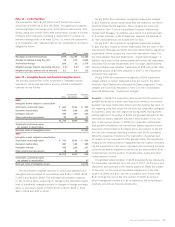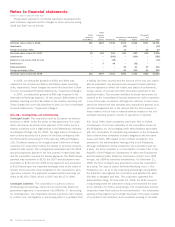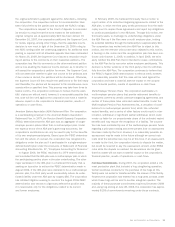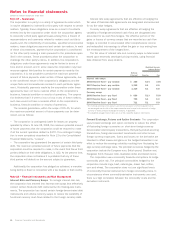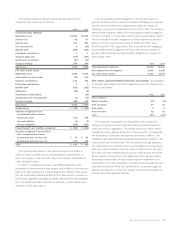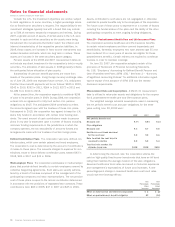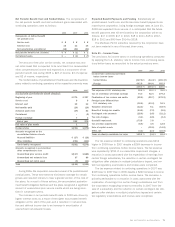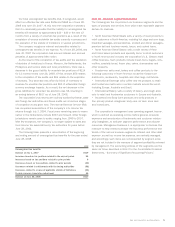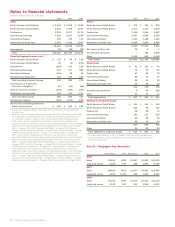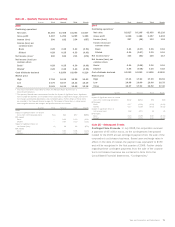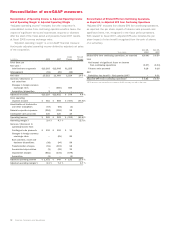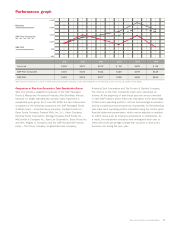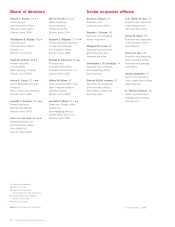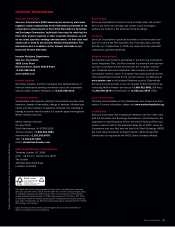Sara Lee 2008 Annual Report Download - page 74
Download and view the complete annual report
Please find page 74 of the 2008 Sara Lee annual report below. You can navigate through the pages in the report by either clicking on the pages listed below, or by using the keyword search tool below to find specific information within the annual report.
Notes to financial statements
Dollars in millions except per share data
The corporation recognized income tax expense of $194 in 2007
and $529 in 2006 related to certain earnings outside of the U.S.
which were not deemed to be indefinitely reinvested. Hanesbrands
historically generated a significant amount of cash from operations
in the U.S. and this cash was used to service the corporation’s debt,
as well as to pay dividends and support domestic capital require-
ments. As a result of the 2007 spin off of Hanesbrands and the
disposition of a number of significant European operations, the level
of cash necessary to finance the domestic operations and the cash
considered to be permanently invested outside the U.S. was modi-
fied at the end of 2006. Aside from the items mentioned above, the
corporation intends to continue to invest certain earnings outside
of the U.S. and, therefore, has not recognized U.S. tax expense
on these earnings. U.S. federal income tax and withholding tax on
these foreign unremitted earnings would be approximately $425
to $450 for 2008 and $375 to $400 for 2007.
Current and deferred tax provisions (benefits) were:
2008 2007 2006
Current Deferred Current Deferred Current Deferred
U.S. $310 $(247) $÷18 $(144) $÷96 $«256
Foreign 168 (32) 123 4 29 (224)
State (10) 12 (4) (8) 23 (22)
$468 $(267) $137 $(148) $148 $÷«10
Cash payments for income taxes from continuing operations
were $459 in 2008, $378 in 2007 and $121 in 2006.
The deferred tax liabilities (assets) at the respective year-ends
were as follows:
2008 2007
Deferred tax (assets)
Pension liability $÷«(192) $÷«(246)
Employee benefits (97) (129)
Unrealized foreign exchange (187) (227)
Nondeductible reserves (193) (188)
Net operating loss and other tax carryforwards (384) (407)
Other (19) (57)
Gross deferred tax (assets) (1,072) (1,254)
Less valuation allowances 283 374
Net deferred tax (assets) (789) (880)
Deferred tax liabilities
Property, plant and equipment $÷««166 $÷÷174
Intangibles 274 278
Unrepatriated earnings 125 418
Deferred tax liabilities 565 870
Total net deferred tax (assets) liabilities $÷«(224) $÷÷(10)
Tax-effected net operating loss and other tax carryforwards
expire as follows: $22 in 2009, $2 in 2010, $21 in 2011, $1 in
2012, $1 in 2014, $2 in 2018, $26 in 2021, $9 in 2022, and $3
in 2023. There is no expiration date on $259 of net operating loss
carryforwards. There are state net operating losses of $38 that
expire in 2009 through 2028.
Valuation allowances have been established on net operating
losses and other deferred tax assets in the United Kingdom, Brazil
and other foreign and U.S. state jurisdictions as a result of the
corporation’s determination that there is less than a 50% likelihood
that these assets will be realized. The pension deferred tax assets
and valuation allowance amounts for 2007 have been revised from
the prior year’s presentation in order to reflect both the deferred tax
asset and full valuation allowance related to U.K. pension liabilities.
In June 2006, the FASB issued FASB Interpretation No. 48
“Accounting for Uncertainty in Income Taxes – an Interpretation of
FASB Statement 109” (FIN 48), which provides guidance on the
financial statement recognition, measurement, reporting and disclo-
sure of uncertain tax positions taken or expected to be taken in
a tax return. FIN 48 addresses the determination of whether tax
benefits, either permanent or temporary, should be recorded in the
financial statements. For those tax benefits to be recognized, a tax
position must be more-likely-than-not to be sustained upon exami-
nation by the tax authorities. The amount recognized is measured
as the largest amount of benefit that is greater than 50% likely of
being realized upon audit settlement.
The company adopted and applied FIN 48 on July 1, 2007
and recognized an increase to the retained earnings component
of shareholder’s equity of $13.
Sara Lee Corporation and eligible subsidiaries file a consolidated
U.S. federal income tax return. The company uses the asset-and-
liability method required by SFAS 109 to provide income taxes on
all transactions recorded in the consolidated financial statements.
This method requires that income taxes reflect the expected future
tax consequences of temporary differences between the carrying
amounts of assets or liabilities for book and tax purposes. Accordingly,
a deferred tax liability or asset for each temporary difference is
determined based upon the tax rates that the company expects
to be in effect when the underlying items of income and expense
are realized. The company’s expense for income taxes includes the
current and deferred portions of that expense. A valuation allowance
is established to reduce deferred tax assets to the amount the
company expects to realize.
Due to the inherent complexities arising from the nature of the
company’s businesses, and from conducting business and being
taxed in a substantial number of jurisdictions, significant judgments
and estimates are required to be made. Agreement of tax liabilities
between Sara Lee Corporation and the many tax jurisdictions in
which the company files tax returns may not be finalized for several
years. Thus, the company’s final tax-related assets and liabilities
may ultimately be different from those currently reported.
72 Sara Lee Corporation and Subsidiaries



